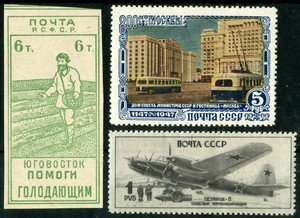RUSSIA IS HOT!

Siberia in January can be very cold, it is true. A temperature of minus 153 degrees F was recorded in Oymyakon in 1933, not a good holiday destination then (Stalin's purges) or even now. However, Russia is definitely HOT in terms of demand for their stamps. Why?
In the early postwar period, when many of us began collecting stamps, Russia was notorious for flooding the market with cancelled-to-order commemoratives celebrating Soviet achievements and famous astronauts. Prolific printers, Russia has issued close on 10,000 different stamps to date, nearly all printed in large quantities, and that's not counting Civil War issues, and the new separatist republics. So, Russian stamps should be common, and should often appear on our lists.
However, this is not the case. The supply has dried up. Currently, doing business with Russia (even stamps) is out of bounds. Infrequently a collection comes up at auction, and sells at a high percentage of SG catalogue value. What happened?
The answer : the Putin era Russian economy has a wide split between rich and poor, linked with strong nationalist patriotism, so making Russian stamps a good investment (speculation!) for well-off Russians with an interest in their nation's history. Most Russian collections have found their way back to the mother country, and demand is still greater than supply.
Prewar Spain, Iceland, Baltic States, Posthorn issues of Norway, 19th century Hungary are further examples where collections sell quickly when they come into stock. Whilst there is no strong speculation in these areas, stamp printing figures were low, and these issues permit interesting specialist study, so have a small but determined following.
Curiously the same factors should apply to prewar Portugal and Romania. Both countries are complex for a serious collector, but often sell at a very modest price in relation to catalogue. It seems to be simply that, so far, there are few collectors of these countries, a minuscule number even in their own country, and the national economies there are weak. So, a good long-term investment tip, if these two undervalued countries become noticed?
Another thought, for some other long-neglected areas such as Spanish and Portuguese colonies, the catalogues have never caught up with pricing in relation to scarcity, but one day there may be huge leaps to catch up, which often (belatedly!) encourages demand.
For many years, West German and West Berlin made roughly parallel issues and most collectors of modern Germany wanted both sets of issues. However, print quantities were much smaller for West Berlin, in view of the much smaller population of Berlin versus West Germany (2 million versus 62 million). So, West Berlin collections sell at a much higher percentage of SG, and disappear faster too, simply because of the smaller quantities issued.
So, why am I writing a blog about stamp collections that I find difficult to source, when demand is already keen and money waiting? Well, partly to explain habitual absences on our COLLECTIONS lists of certain countries, and also to explain to collectors that pricing is NOT about a straight percentage of catalogue, but rather an up-to-date and studied reflection of market forces and collecting habits.
- Published
- 23/01/22 10:00:00 AM
